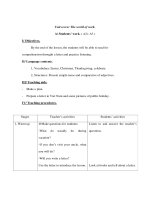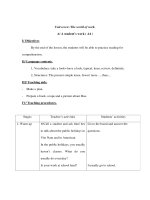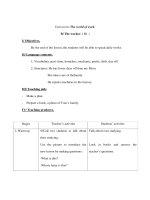4 14 faster, easier, better the world of inventions
Bạn đang xem bản rút gọn của tài liệu. Xem và tải ngay bản đầy đủ của tài liệu tại đây (3.47 MB, 10 trang )
Fascinating Facts
• An inventor working on radar got the idea for
the microwave oven after radio waves melted a
chocolate bar in his pocket.
• The modern zipper, invented in 1912, was named
for the sound it made when it was used to close
rubber boots.
• Clarence Birdseye, who invented a way to freeze
food for sale, got the idea from watching the Inuits
in Canada.
Genre
Nonfiction
Comprehension Skill
Summarize
Text Features
• Time Line
• Captions
Scott Foresman Social Studies
ISBN 0-328-14851-2
ì<(sk$m)=beifbg< +^-Ä-U-Ä-U
In this book you will read about innovations that
occurred in the 1800s and 1900s. New machines
and new ways of doing things changed the daily
lives of people throughout the United States and
around the globe. The advancements of these two
centuries altered the world forever and helped
shape the world we live in.
Vocabulary
industrialization
hydropower
invention
urban
rural
steamboat
communication
computer software
Write to It!
We often cannot imagine living without a
particular device—an alarm clock, for example, or
a television. List three devices you think you could
not live without. How would your life be different
without them? What would you use or do instead?
Write a short essay that answers these questions.
Write your essay on a separate sheet of paper.
Photographs
Every effort has been made to secure permission and provide appropriate credit for photographic material. The publisher deeply
regrets any omission and pledges to correct errors called to its attention in subsequent editions.
Unless otherwise acknowledged, all photographs are the property of Scott Foresman, a division of Pearson Education.
Photo locators denoted as follows: Top (T), Center (C), Bottom (B), Left (L), Right (R) Background (Bkgd)
ISBN: 0-328-14851-2
Copyright © Pearson Education, Inc.
All Rights Reserved. Printed in the United States of America. This publication is protected
by Copyright, and permission should be obtained from the publisher prior to any prohibited
reproduction, storage in a retrieval system, or transmission in any form by any means,
electronic, mechanical, photocopying, recording, or likewise. For information regarding
permission(s), write to: Permissions Department, Scott Foresman, 1900 East Lake Avenue,
Glenview, Illinois 60025.
1 2 3 4 5 6 7 8 9 10 V0G1 14 13 12 11 10 09 08 07 06 05
Opener: © Mark Richards/PhotoEdit
Editorial Offices: Glenview, Illinois • Parsippany, New Jersey • New York, New York
3 ©North Wind Picture Archives
4 ©Getty Images
Sales Offices: Needham, Massachusetts • Duluth, Georgia • Glenview, Illinois
6 ©National Archives
Coppell, Texas • Sacramento, California • Mesa, Arizona
8 ©Corbis
10 ©The Granger Collection, NY
12 ©Ed Quinn/Corbis
13 © Dennis Degnan/Corbis
14 ©Ewing Galloway/Camerique Inc., Int’l/Retrofile.com
15 ©Minnesota Historical Society/Corbis
Changing the Way America Works
Until the early 1800s most families in the United
States lived on farms and were self-sufficient. This
means that they grew their own food, spun their
own thread, and wove their own cloth. They bought
only what they were unable to make—tools, shoes,
and some furniture, for example. Blacksmiths,
cabinetmakers, and other craftspeople manufactured
special items such as these in small workshops.
Around 1820 factories began to appear in the
northeastern states. New machines could turn out
many products more quickly and more cheaply
than people could make them at home. Over the
next fifty years, setting up and running businesses
and factories—a process called industrialization—
changed the way Americans lived and worked.
Some of the earliest factories were cotton mills,
where machines made thread and cloth. Hydropower
made the machines run. Swift flowing rivers and
streams turned water wheels, and hour after hour, the
turning wheels kept the machines going.
The new factories were like magnets. By 1836 more
than twelve thousand young women, raised on farms,
had relocated to Lowell, Massachusetts. They moved
there to work in the cotton mills. They lived in rented
rooms and labored thirteen hours a day every day
except Sunday. It was hard work, but many enjoyed
the changes in their lives. They liked being away from
home and earning more than two dollars a week—
excellent pay in those days.
2
3
Teenagers and young women left
their families’ farms to work long
hours in cotton mills.
Tractors help farmers pull
heavy equipment much more
easily than they ever could
by hand or with the help of
horses. They also help farmers
cover a large field quickly.
Changes in Farming Methods
To grow one hundred bushels of wheat in 1830,
a farmer with five acres of land had to work three
hundred hours. In 1987 a farmer could raise one
hundred bushels on three acres of land with only three
hours of work.
What made this possible? Inventions did. An
invention is a new machine or new way of doing
something. Inventors built machines that helped
farmers work faster and accomplish more. Four
important examples of inventions that improved
farming methods are shown in the time line.
Before 1920 at least one out of every two Americans
worked on farms. Today only one in fifty Americans
do. Yet, incredibly, America’s farms are now producing
more food than ever in history.
4
Farm Inventions 1780–1900
1793
1860
Cotton Gin
Eli Whitney
invented a
machine to pick
cottonseeds
from cotton.
1750
1800
Automatic Milker
Leighton O. Colvin
invented the first
useful machine
for milking cows.
1850
1900
1834
1892
Mechanical Reaper
Cyrus Hall McCormick built a
machine to harvest wheat.
Tractor
A blacksmith in Iowa
put a gasoline engine
on iron wheels.
5
The Age of Electricity
Thomas Edison was the first American to invent a
light bulb that did not burn out quickly. In 1879 he
held a New Year’s Eve party to show off his invention.
About three thousand people visited Edison’s house
and laboratory in Menlo Park, New Jersey. Electric
lights glowed all around the property, and the visitors
were amazed. Edison told them they would be able to
discard their smelly kerosene lanterns and dangerous
gas lamps in the years ahead.
In the late 1800s Edison supervised the
construction of a coal-fired electric power plant
in New York City. Underground wires carried the
electricity into homes and offices. Factories could now
stay open all night.
Stringing wires long distances was expensive. As
a result, homes in urban areas got electricity first.
Many homes in rural areas, which were not as densely
populated as cities, had no electricity until the 1940s.
Today it is hard to imagine life without electricity.
What would we do without radios and motion
pictures that were invented in the 1890s? What if
our towns and cities had no traffic lights that were
invented in 1914? Electricity is such an important
part of modern life that electric companies have had
to build power plants all across the nation.
Thomas Edison
prepared this drawing
for the United States
Patent Office, which—
even today—continues
to give inventors the sole
right to make and sell
their inventions.
7
The Rise of Transportation
During the 1800s the need to get goods to market
created a growing need for transportation. The
steamboat and the canal boat helped move people
and goods over water, and new roads helped link cities
and towns over land.
In 1830 a New York inventor named Peter Cooper
pieced together a steam locomotive called the Tom
Thumb. It carried more than two dozen passengers
at an average speed of ten miles an hour. By 1869
trains were crisscrossing the nation from New York to
California.
New ideas about transportation came to light when
automobiles appeared. The first cars ran on steam or
electric batteries, and the first car owners tended to
be wealthy. That changed in 1908, when Henry Ford
built the Model T car. This new car was cheap, sturdy,
and easy to drive and repair. About fifteen million
people in the United States bought a Model T in the
nineteen years it was in production.
Airplanes transformed travel too. In 1903 the first
motor-powered plane took off from a sand dune in
Kitty Hawk, North Carolina. Its first flight lasted for
only twelve seconds. Today’s jumbo jets can stay aloft
for fourteen hours without refueling.
The changes in transportation reinvented the
nation’s economy. Farmers grew more, because trains
could haul their crops hundreds of miles to markets.
Roadside motels sprang up to accommodate travelers.
Increases in car ownership and roadways also led to
suburbs, shopping malls, and new businesses. The
businesses provided employment for pilots, mechanics,
truck drivers, road builders, and millions of others.
Automobile races, which started in the
United States in 1895, boosted people’s
interest in owning cars—especially fast ones.
9
Trains were faster
than horses, and
telegrams were
faster than trains.
Inventions such
as these made the
world seem smaller.
From April 1860 to October 1861, young men
on horseback carried mail back and forth between
Missouri and California. Riding for the Pony Express
paid well—one hundred dollars a month—but the job
had no future. Once telegraph wires were strung from
the East Coast to the West Coast, horses could not
compete. Telegrams were expensive to send, but no
horse traveled faster than the time it took a message to
travel though the wires.
Like other means of information exchange, or
communication, the telegraph (invented in 1837)
made the world seem smaller. It allowed people
separated by thousands of miles to communicate
more easily.
After Alexander Graham Bell invented the telephone
in 1876, the world seemed to shrink even more. Wires
connecting homes and offices allowed people to hold
actual conversations over long distances.
Then in 1894 the Italian inventor Guglielmo
Marconi transmitted Morse code signals over the
air. His “wireless” later came to be called radio, and
the world’s first radio station–KDKA in Pittsburgh,
Pennsylvania–gave the first voice broadcast in 1920.
10
11
Faster Communication
The Internet Era
Tim Berners-Lee is one of the most significant
inventors of the last hundred years. Over a two-year
period, from 1989 to 1991, he invented the World
Wide Web. The “Web” is a system that lets people
share the information kept in computers.
The Web and the Internet are not the same thing.
The Internet is a network of electronic “highways.”
The Web is like a chain of electronic trucks that carry
words, sound, and pictures over that network.
The Internet was invented in 1969. Scientists used
it to send e-mail to each other and to share collections
of information called databases.
Berners-Lee opened up the Internet to millions of
people. He did it by writing five kinds of computer
software. One set of instructions made it possible
to put Web sites on the Internet. Another gave these
Web sites addresses, or URLs. Two others let people
move documents between computers and browse, or
surf, the Web.
Tim Berners-Lee invented the
World Wide Web in the late
1980s. He and other software
writers have been improving it
ever since.
You can use the World Wide Web to find information about
almost anything—from a recipe for gazpacho to the winners
of the 1918 World Series.
The fifth program made servers work. Servers
are computers that stay on all the time. They store
databases and serve them to users who want to access
the databases. Worldwide, there are millions of
servers.
The Web caught on fast. Nearly one million people
around the globe went online in 1991. At that time
almost all of them used it for e-mail, for which the
Web is not needed. In 2003 thanks to the Web, nearly
six hundred million people had Internet access.
Surfing the Web can be entertaining. However,
students who rely on it for help with research and
homework are also aware of its value as an educational
tool. The Web lets people tap into sources of
information faster and more easily than ever before.
13
The Five Most Important
Inventions in the United States
Inventions change lives. Nothing makes that clearer
than a survey taken by researchers at the University
of Florida in 1999. They asked Americans which
inventions had the greatest impact on their lives. Here
are the top five responses:
1. Computers
2. Television
3. Refrigerators
4. Medical Advances
5. The Internet
The invention of each of these items has a long
history. The ancestry of computers stretches back to
an Englishman named Charles Babbage (1791–1871).
In 1833 he began to design an “analytical engine.”
His plan, which was never finished, was to build a
machine to solve complicated math problems.
Twentieth-century inventors helped
make food safer and more convenient
to store and created new sources of
entertainment and information.
Television had many parents,
starting with the invention of
the photoelectric cell in 1913
and the invention of both
mechanical and electronic
televisions in 1923.
The first refrigeration
machine was invented in
1805, but home refrigerators
did not begin entering
American kitchens until
1916. In 1920 refrigerators were in about twenty
thousand homes. By 1936 two million families in the
United States owned one.
The average life expectancy of Americans born in
1900 was forty-nine years. Americans born in 2000
can expect to live an average of seventy-seven years.
New medicines, devices like the MRI (magnetic
resonance imaging), inventive surgical procedures, and
other medical innovations are responsible for most of
these gains.
Experts call the world we live in today “the
information age.” The Internet, the home of the
World Wide Web, is one of the major reasons why.
15
In this book you will read about innovations that
occurred in the 1800s and 1900s. New machines
and new ways of doing things changed the daily
lives of people throughout the United States and
Glossary
around the globe. The advancements of these two
centuries
altered the
forever
andsend
helped
communication
theworld
way that
people
and
shape
the information
world we live in.
receive
computer software programs that help
computers perform
certain functions
Vocabulary
hydropower power
produced by capturing the
industrialization
energy of flowing water
hydropower
industrialization the creation of businesses and
invention
factories in a country or region
urban
invention a new machine or new way of
doing something rural
steamboat
rural in small towns
or farms
communication
steamboat a boat
powered by a steam engine
computer software
urban in the city
Write to It!
We often cannot imagine living without a
particular device—an alarm clock, for example, or
a television. List three devices you think you could
not live without. How would your life be different
without them? What would you use or do instead?
Write a short essay that answers these questions.
Write your essay on a separate sheet of paper.
Photographs
Every effort has been made to secure permission and provide appropriate credit for photographic material. The publisher deeply
regrets any omission and pledges to correct errors called to its attention in subsequent editions.
Unless otherwise acknowledged, all photographs are the property of Scott Foresman, a division of Pearson Education.
Photo locators denoted as follows: Top (T), Center (C), Bottom (B), Left (L), Right (R) Background (Bkgd)
ISBN: 0-328-14851-2
Copyright © Pearson Education, Inc.
All Rights Reserved. Printed in the United States of America. This publication is protected
by Copyright, and permission should be obtained from the publisher prior to any prohibited
reproduction, storage in a retrieval system, or transmission in any form by any means,
electronic, mechanical, photocopying, recording, or likewise. For information regarding
permission(s), write to: Permissions Department, Scott Foresman, 1900 East Lake Avenue,
Glenview, Illinois 60025.
1 2 3 4 5 6 7 8 9 10 V0G1 14 13 12 11 10 09 08 07 06 05
16
Opener: © Mark Richards/PhotoEdit
3 ©North Wind Picture Archives
4 ©Getty Images
6 ©National Archives
8 ©Corbis
10 ©The Granger Collection, NY
12 ©Ed Quinn/Corbis
13 © Dennis Degnan/Corbis
14 ©Ewing Galloway/Camerique Inc., Int’l/Retrofile.com
15 ©Minnesota Historical Society/Corbis









